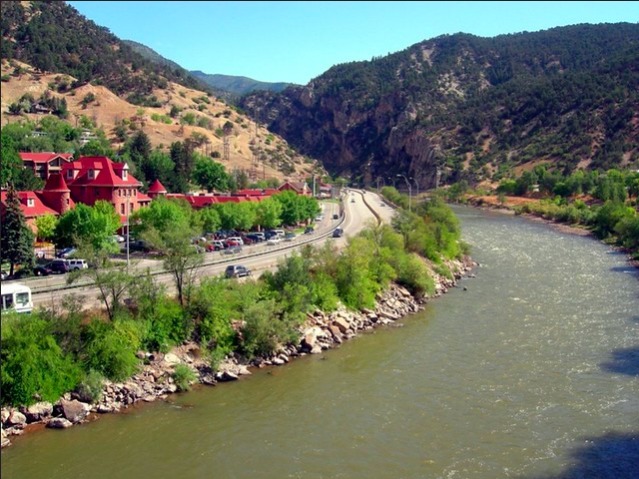The Yampah Vapor Caves

History Colorado Online Collection # 86.200.452.
http://5008.sydneyplus.com/HistoryColorado_ArgusNet_Final/Portal.aspx?lang=en-US Creator: Photo by William Henry Jackson 1843 – 1942
As the United States became more and more industrialized in the nineteenth and twentieth centuries, Americans looked for relaxation and rejuvenation. In the West, they found natural spas marketed to restore their mind and body.
The Yampah Vapor Caves are a unique natural feature among the many mineral hot springs in Colorado. Vapor from the Glenwood Hot Springs is captured in underground caves, creating a natural steam bath. The Ute peoples used these caves for centuries before the arrival of white settlers. Yampah was a site for sacred rituals, where the Utes used the vapor caves to heal their sick.
Settlers established the city of Glenwood Springs in 1883. It quickly became a town devoted to the health and wellness offerings of its hot springs, with its economy focused on tourism. A travel guide published in 1908 by the Rock Island and Pacific Railway Company referred to the city as "the most attractive Resort in Colorado." In 1887, William Devereaux secured the land rights to all of the mineral springs in the area through the Colorado Land and Improvement Company. He built the successful Colorado Hotel, then opened the Yampah Vapor Caves as a commercial business and invited guests to soak in the mineral steam. While this institution could have been advertised as a sanatorium, an institution designed to restore a person’s health, Devereaux advertised the vapor caves as a spa. By making this choice, Deveraux created a luxury experience rather than a medical one. Visitors to the Vapor Caves were not seeking a cure to a disease, but rather a relaxing natural experience. As a business, the Yampah Vapor Caves were successful enough that Deveraux built a separate resort specifically for them.
The Vapor Caves were very popular during the turn of the century, as Americans began traveling West in search of cures for respiratory diseases such as tuberculosis. After the prevalence of the disease began to decrease in the 1940s, the resort still managed to prosper, catering to the new wellness tourism market. Wellness tourism is travel focused on promoting health and well-being, rather than just recreation. This became popular as Americans had more money for leisure and sought escape from the city. During WWII, veterans returning from combat used the Vapor Caves to recuperate from their injuries.
Many famous people have visited the caves, including Doc Holliday and Theodore Roosevelt. Yampah continues to serve as a resort, catering to visitors looking to utilize the health benefits of mineral springs. Because the resort is a natural spa, it does not offer extravagant amenities. It is affordable, allowing it to continue to survive despite declining travel markets, as it has become a viable vacation option for families. The Yampah Vapor Caves still attract visitors seeking wellness and rest, making them a stalwart fixture in Glenwood Springs.
Images

History Colorado Online Collection # 86.200.452.
http://5008.sydneyplus.com/HistoryColorado_ArgusNet_Final/Portal.aspx?lang=en-US Creator: Photo by William Henry Jackson 1843 – 1942

History Colorado Accession # 86.200.450.
http://5008.sydneyplus.com/HistoryColorado_ArgusNet_Final/Portal.aspx?lang=en-US Creator: Photo by William Henry Jackson 1843 – 1942.

https://www.flickr.com/photos/23155134@N06/6002856901/in/photolist-a9sddM-7WU15W-aZpSfa-5ayFAJ-rWowEd-7ATwLD-9BLhDX-7zU1Bi-oE59zr-byi6U8-8Ms7Pm-8yooBf-7unm1V-8yk47H-9AP2dh-8td83k-ncD8rZ-ncD9Rn-8Ms7mL-9AL862-9AP2zQ-5aujRV-8ThQ8V-8yk31R-8tdraD-7WQJcD-9BPeSJ-7WTVUs-8PdqBU-7WTWAS-7ur4zx-8wrXyH-8yk2v2-8tea36-dcxo7q-8BLUUK-8yk3Re-a9sd3e-8yjW8R-9BLioz-dBZxJ6-9BLi34-oCJhBr-6GeqtX-6Giqm7-6GiuFW-6Geqmv-72oAE-9Y9gSH-7fDu77/ Creator: Photo taken by Don Graham.